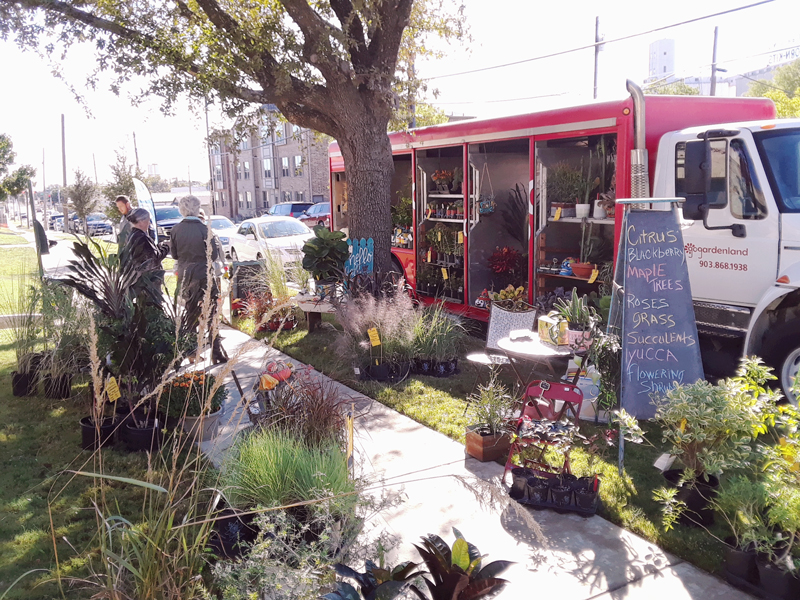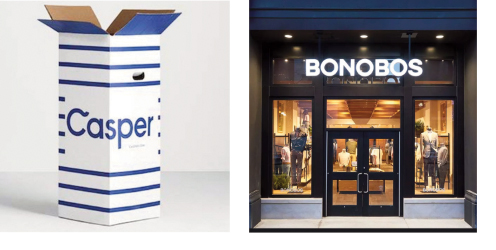12/1/2019
Unconventional Retail
Jennifer Polanz
Mobile Sales
Gary Milton’s idea for a mobile plant truck was born out of necessity.
He and his wife owned a nursery in Sherman, Texas, north of Dallas, but health issues prompted them to sell it (consequently, that location is now solely an event/wedding venue—a business Gary had built alongside the retail sales). They relocated the greenhouses to their home and began thinking of alternatives to traditional garden retail.
“I got to thinking about the food truck industry and thought, ‘Well, why can’t I do this with plants?’” he says. “Demand isn’t going to be like food trucks, but I think I can make it.”
His son, who worked at a car dealership, got a lead on a delivery truck, which was the exact style Gary was hoping for. “It’s a 10-bay beverage truck. It looks like a Coca-Cola truck, but it’s a Community Coffee truck,” he notes. “It had a white cab and red body, which was kind of our colors anyway. I thought, ‘Well this is handy, we don’t have to repaint the truck!’”
He built adjustable racks to put the plants in, and loads up plants and seasonal products to head off to various events like garden club meetings, local arboretum field trials and festivals. He tried parking it on a corner lot on certain days, but found that didn’t draw as many customers as actual events.
“That’s probably the only thing I didn’t enjoy,” he adds. “I didn’t like just driving up and sitting on a street corner waiting for people to drive up.”
 After a year under his belt, he’s found a wide variety of events that are worth making the trek for, including a farmers market-type event in a local housing division. “The first one was supposed to start at 1:00 p.m.,” he says. “I looked up at 1:00 p.m. and people were coming out of their houses with their baby strollers—it was like a fair.”
After a year under his belt, he’s found a wide variety of events that are worth making the trek for, including a farmers market-type event in a local housing division. “The first one was supposed to start at 1:00 p.m.,” he says. “I looked up at 1:00 p.m. and people were coming out of their houses with their baby strollers—it was like a fair.”
He’s learned to adapt his buying habits to accommodate the unusual nature of the truck, and now he knows how to park it just right so the wind doesn’t blow the plants over and the sun doesn’t beat down into the truck. He only rolls up the doors on one side so the other side acts as a giant billboard.
His advice for anyone looking to take on a plant truck? “Just know what you don’t like to do and what you’re willing to do,” he says. “Setting up with the groups and garden shows, event type of things when you know there’s going to be a lot of foot traffic, not just drive-by traffic, has worked.”
Also, they’re having a heck of a lot of fun with the new gig. “We’re enjoying it,” he says. “We haven’t hardly thrown any rocks at it yet, unless we get up and the weather report says it’s going to rain.”
Well, some things never change.
Zero Inventory
I first read the term Zero-Inventory Stores (ZIS) in a Pam Danziger enewsletter that she sent in mid-October. She also wrote a story for the Forbes website about it, citing multiple retailers who’re trying it, including online retailers like Bonobos and Casper, as traditional brick-and-mortar stores like Nordstrom and IKEA.
So what is it? Simply put, it’s a showroom where customers can try on or interact with products, and then order products to be delivered to their home. It eliminates the need for lots of inventory, large store footprints and labor to handle inventory. The concept is now rooted in some scientific evidence that shows the benefits of stores like this, as Pam noted in her newsletter.
 A collaborative paper published recently by researchers at the Wharton School of the University of Pennsylvania and Harvard Business School studied two million transactions from Bonobos to highlight the benefits. From the abstract: “We find that post the ZIS experience, customers spend more, shop at a higher velocity and are less likely to return items. The positive impact on returns is doubly virtuous, as it is more pronounced for more tactile, higher-priced items, thus mitigating a key pain point of online retail. Furthermore, the ZIS shopping experience aids product discovery and brand attachment, causing sales to become more diffuse over a larger number of categories.”
A collaborative paper published recently by researchers at the Wharton School of the University of Pennsylvania and Harvard Business School studied two million transactions from Bonobos to highlight the benefits. From the abstract: “We find that post the ZIS experience, customers spend more, shop at a higher velocity and are less likely to return items. The positive impact on returns is doubly virtuous, as it is more pronounced for more tactile, higher-priced items, thus mitigating a key pain point of online retail. Furthermore, the ZIS shopping experience aids product discovery and brand attachment, causing sales to become more diffuse over a larger number of categories.”
Now this approach was largely created by online retailers seeking stronger customer relationships, but could it work for garden retail? It would be a challenge for a vast majority of stores, as many items like color annuals and perennials are impulse purchases. However, could this work on big-ticket items like statuary, fountains, patio furniture, etc.? Possibly.
Retailers looking to reduce their size or those who’re having labor issues might consider this concept for certain departments. It would require an online e-commerce presence and either delivery or in-store pickup logistics. The beauty of this concept is it still emphasizes the in-store experience, which customers seem to continue to want.
One of the paper’s authors, Santiago Gallino of Wharton, sat down for a podcast interview and said this about the ZIS concept: “Nowadays we are all comfortable with navigating a website, understanding what products are offered, but we also think, ‘It would be nice if I could actually touch this product. It would be nice if I could ask a well-informed sales associate a question or point me towards another option if the product is out of stock.’
“I think that those interactions can happen better in a physical context, and companies are looking into that and using that as a tool to have more contact with their customers.” GP